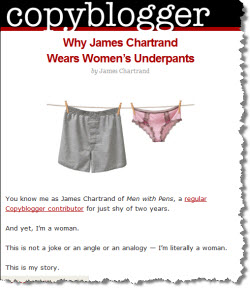 I’ve seen this in surveys several times: Americans dream of owning their own business. We’re a culture of startups. But don’t just dream your startup. Do it. Make it happen.
I’ve seen this in surveys several times: Americans dream of owning their own business. We’re a culture of startups. But don’t just dream your startup. Do it. Make it happen.
Just because you love it doesn’t make it easy
I really like this from Pam Slim, author of Body of Work, in Who says following your dreams shouldn’t be hard? She says:
I have come to the realization that we cause ourselves a lot of stress by believing that if we just choose the right business, or quit our loathsome job, or find the perfect Internet marketing system, or get that book deal that things will become easy.
She goes on to point out that most of what we get in life, most of the good things, are also hard. There are lots of clichés on that point. Pam suggests that there is good hard — such as “Meeting unexpected life challenges with both pragmatism and optimism” — and bad hard — like “Spending twelve hours on an administrative task that is complex, boring and not your strength when someone smart could do it in 30 minutes for fifty bucks.”
There was a scene in one of those old black-and-white movies in which the fabulously rich guy is asked the secret of success and he answers: “Choose rich parents.”
For the rest of us, it has to do with work. As in another old saying I like: “The harder I work, the luckier I get.”
Success takes a lot of work
Which brings me to one of the basic fundamentals of building a new business, or running an existing business: it’s a lot of work. You have to build it around a need that other people have, or something that other people want. It has to be not just what you want to do, but what somebody else will pay money for. You develop strategy, tactics, and of course the business offering. You gather a team and necessary resources. You make decisions. You take risks. You spend a lot of time. You do a lot of work. You make a lot of mistakes along the way
Be your own boss? Well, maybe, but the toughest bosses are their own bosses. The buck stops with you. You make the decisions. Even the work you don’t do is still your responsibility, so you have to develop tasks and measurements and accountability. You plan constantly, because you do a simple plan and revise it frequently.
Somewhere embedded in all this is that you work on what you love, because to be successful you’re going to work on it a whole lot, so you’d better love it.
And, also, that the opposite of hard is boring.
Which brings me to my title above. Following dreams isn’t enough. You have to build dreams.



 These all seem useful to the small business owner and entrepreneur.
These all seem useful to the small business owner and entrepreneur. “Do something that matters,” Megan answered. “Do something special.” She talked about favorites, lessons, advice, and reflections.
“Do something that matters,” Megan answered. “Do something special.” She talked about favorites, lessons, advice, and reflections. I’ve worried about this for years. I used to deal with a guy who did very well as a professional expert, while knowing not much more than what he’d read the in a trade journal or two the night before a presentation. That never bothered him. And he did very well. And it kind of bothered me.
I’ve worried about this for years. I used to deal with a guy who did very well as a professional expert, while knowing not much more than what he’d read the in a trade journal or two the night before a presentation. That never bothered him. And he did very well. And it kind of bothered me.

You must be logged in to post a comment.